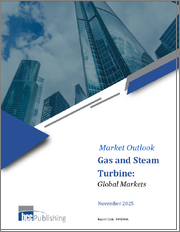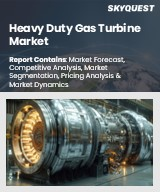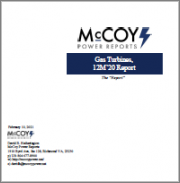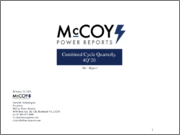
|
시장보고서
상품코드
1400710
세계의 터빈 시장 평가 : 유형별, 출력 범위별, 최종 이용 산업별, 지역별, 기회 및 예측(2017-2031년)Turbines Market Assessment, By Type, By Power Range, By End-user Industry, By Region, Opportunities and Forecast, 2017-2031F |
||||||
세계 터빈 시장 규모는 2023년 997억 달러, 2031년에는 1,389억 9,000만 달러에 달할 것으로 예상되며, 2024-2031년의 예측 기간 동안 연평균 4.24% 성장할 것으로 예상됩니다.
터빈의 보급은 에너지 수요 증가, 터빈 기술의 발전, 전 세계적으로 지속 가능한 에너지원으로의 전환에 의해 추진되고 있습니다. 시장 성장의 원동력은 전력 인프라에 대한 투자 증가, 청정 에너지 솔루션에 대한 관심 증가, 항공우주 산업의 지속적인 확장 등입니다.
터빈에 대한 투자는 여러 가지 요인으로 인해 증가하고 있습니다. 에너지 수요 증가와 지속 가능한 관행으로의 전환은 터빈 기술에 대한 자금 지원을 증가시키고 있습니다. 각국 정부는 청정 에너지에 대한 인센티브를 제공함으로써 풍력 및 수력 터빈에 대한 투자를 촉진하고 있습니다. 또한, 터빈의 효율성과 신뢰성이 향상되면서 투자자들의 신뢰가 높아지고 있습니다. 또한, 항공우주산업과 해양산업의 확장은 가스 터빈 수요를 촉진하고 있습니다. 이러한 복합적인 요인으로 인해 투자가 급증하고 있으며, 터빈은 다양한 분야에서 중요한 구성 요소로 자리매김하고 있습니다.
풍력 터빈의 등장으로 시장 성장 촉진
풍력 터빈의 등장은 발전 산업에 혁명을 일으켜 시장 성장을 크게 촉진하고 있습니다. 이러한 변화는 풍력 발전 비용의 하락, 풍력 터빈 제조업체들의 경쟁 심화, 재생 에너지로의 전환을 촉진하는 환경 문제 증가, 터빈의 효율과 출력을 향상시키는 기술 발전 등의 요인에 기인합니다. 이러한 촉진요인으로 인해 풍력 터빈은 기존 화석연료를 사용하는 발전 방식에 비해 비용 효율성이 높아져 에너지 생산자와 소비자 모두에게 매력적인 선택이 되고 있습니다.
가스터빈의 보급으로 시장 성장 가속화
가스 터빈의 보급이 세계 터빈 시장의 큰 성장을 견인하고 있습니다. 이는 효율적이고 신뢰할 수 있는 발전 솔루션에 대한 수요 증가, 기존 화석연료보다 천연가스를 선호하는 엄격한 환경 규제, 터빈 성능 향상과 배출가스 감소를 위한 기술 발전 등 다양한 요인에 기인합니다. 그 결과, 가스 터빈은 복합화력 발전소, 산업용 발전 시스템, 석유 및 가스 처리 시설 등 다양한 발전 분야에서 점점 더 많이 사용되고 있습니다.
석유 및 가스 산업에서 터빈은 엄청난 기회를 제공할 것으로 예상됨
터빈은 석유 및 가스 산업에서 매우 중요한 역할을 하며 다양한 공정과 작업을 추진합니다. 에너지 수요 증가로 석유 및 가스 탐사 및 생산이 증가함에 따라 이러한 공정에 전력을 공급하는 터빈에 대한 수요가 증가하고 있습니다. 또한 엄격한 환경 규제가 시행되면서 보다 효율적이고 깨끗한 터빈 기술 개발이 촉진되어 석유 및 가스 기업에게 터빈은 최고의 선택이 되고 있습니다.
아시아태평양이 터빈 시장을 주도하고 있습니다.
아태지역은 산업화와 인프라 개발 등 여러 요인으로 인해 세계 터빈 시장을 주도하고 있습니다. 이러한 요인으로 인해 전력 수요가 급증하면서 새로운 발전소에 대한 수요가 증가하고 있습니다. 또한, 중국, 인도 등 아시아태평양의 많은 국가에서 정부 정책으로 인해 터빈을 이용한 풍력 및 태양광 발전과 같은 재생 가능 에너지의 활용이 촉진되었습니다. 이러한 요인들로 인해 아태지역은 세계 최대의 터빈 시장으로 성장하여 전 세계 터빈 매출의 50% 이상을 차지하게 되었습니다.
정부의 이니셔티브이 시장 규모에 영향을 미칠 것
정부의 이니셔티브는 전 세계 터빈 시장에 큰 영향을 미치고 있습니다. 이러한 노력은 재정적 인센티브 제공, R&D 투자, 규제 프로세스 간소화 등을 통해 터빈 사용을 촉진하는 데 도움이 되고 있습니다. 그 결과, 세계 터빈 시장은 최근 몇 년동안 빠른 성장세를 보이고 있으며, 앞으로도 계속 성장할 것으로 예상됩니다.
COVID-19의 영향
코로나19 사태 이전에는 세계 터빈 시장은 비교적 안정적이었습니다. 터빈에 대한 수요는 신뢰할 수 있고 효율적인 발전의 필요성과 재생 가능 에너지의 인기가 높아짐에 따라 촉진되었습니다. 시장은 재생 가능 에너지 사용과 에너지 효율을 촉진하는 정부 정책에 의해 뒷받침되었습니다. 그러나 코로나19 팬데믹의 도래는 세계 터빈 시장에 큰 영향을 미쳤습니다. 팬데믹의 첫 번째 충격파는 공급망이 붕괴되고 여행 제한으로 인해 근로자와 장비의 이동이 제한되면서 2020년 터빈 설치가 감소했습니다. 그러나 각국 정부가 경기부양책을 시행하고 재생에너지에 대한 수요가 크게 증가함에 따라 팬데믹 이후 시장은 회복세를 보이고 있습니다. 이러한 도전에도 불구하고, 재생에너지로의 전환과 효율적이고 신뢰할 수 있는 전원에 대한 수요 증가로 인해 시장의 장기적인 전망은 여전히 긍정적이라고 할 수 있습니다.
이 보고서는 세계의 터빈(Turbines) 시장에 대해 조사 분석했으며, 시장 규모와 예측, 시장 역학, 주요 기업 현황과 전망 등의 정보를 제공합니다.
목차
제1장 조사 방법
제2장 프로젝트의 범위와 정의
제3장 세계 터빈 시장에 대한 COVID-19의 영향
제4장 세계 터빈 시장에 대한 러시아·우크라이나 전쟁의 영향
제5장 주요 요약
제6장 고객의 소리
- 제품과 시장 인텔리전스
- 구입 결정에서 고려되는 요소
제7장 세계의 터빈 시장 전망(2017년-2031년)
- 시장 규모와 예측
- 금액
- 수량
- 유형별
- 증기 터빈
- 가스 터빈
- 수력 터빈
- 풍력 터빈
- 출력 범위별
- 1MW 미만
- 1MW-50MW
- 51MW-200MW
- 201MW-500MW
- 500MW 이상
- 최종 이용 산업별
- 발전
- 석유 및 가스
- 화학제품 및 비료
- 기타
- 지역별
- 북미
- 아시아태평양
- 유럽
- 남미
- 중동 및 아프리카
- 시장 점유율 : 기업별(2023년)
제8장 세계의 터빈 시장 전망 : 지역별(2017년-2031년)
- 북미
- 시장 규모와 예측
- 유형별
- 출력 범위별
- 최종 이용 산업별
- 미국
- 캐나다
- 멕시코
- 유럽
- 독일
- 프랑스
- 이탈리아
- 영국
- 러시아
- 네덜란드
- 스페인
- 남미
- 브라질
- 아르헨티나
- 아시아태평양
- 인도
- 중국
- 일본
- 호주
- 한국
- 중동 및 아프리카
- 사우디아라비아
- 아랍에미리트(UAE)
- 남아프리카공화국
제9장 시장 매핑(2023년)
- 유형별
- 출력 범위별
- 최종 이용 산업별
- 지역별
제10장 거시환경과 산업 구조
- 수급 분석
- 수출입 분석
- 밸류체인 분석
- PESTEL 분석
- Porter의 Five Forces 분석
제11장 시장 역학
- 성장 촉진요인
- 성장 억제요인(과제, 성장 억제요인)
제12장 주요 기업 상황
- 시장 리더 주요 5개사의 경쟁 매트릭스
- 시장 리더 주요 5개사의 시장 매출 분석(2023년)
- 인수합병(M&A)/합병사업(해당하는 경우)
- SWOT 분석(시장 진출기업 5개사)
- 특허 분석(해당하는 경우)
제13장 가격 분석
제14장 사례 연구
제15장 주요 기업 전망
- Bharat Heavy Electricals Limited(BHEL)
- Mitsubishi Hitachi Power Systems Ltd(MHPS)
- Harbin Electric Company Limited
- ABB
- General Electric Company
- Siemens AG
- Doosan Heavy Industries & Construction Co. Ltd.
- Toshiba Corporation
- Dongfang Electric Corporation Limited
- Nordex SE
제16장 전략적 추천 사항
제17장 당사에 대해/면책사항
LSH 24.01.10Global turbines market size was valued at USD 99.7 billion in 2023, which is expected to reach USD 138.99 billion in 2031, with a CAGR of 4.24% for the forecasted period between 2024 and 2031.
Turbines offer efficient energy conversion, crucial in power generation, aerospace, and renewables like wind and hydropower. Turbines are pivotal in addressing energy needs and reducing the overall environmental impact, connecting them to diverse sectors and the evolving energy landscape. The widespread use of turbines is propelled by the increasing energy demand, advancements in turbine technology, and a global shift towards sustainable energy sources. The factors driving the market growth include the rise in investments in power infrastructure, a prominent focus on cleaner energy solutions, and the continuously expanding aerospace industry.
Investments in turbines are on the rise due to several factors. Growing energy demand and a shift towards sustainable practices prompt increased funding in turbine technologies. Governments worldwide are incentivizing clean energy and fostering investment in wind and hydropower turbines. Moreover, advancements in turbine efficiency and reliability contribute to an improvement in the confidence of the investor. Additionally, the expanding aerospace and marine industries are fueling the demand for gas turbines. These combined factors drive a surge in investments, positioning turbines as key components in diverse sectors.
Emergence of Wind Turbines is Proliferating the Market Growth
The emergence of wind turbines is revolutionizing the power generation industry, thereby driving market growth significantly. The transformation stems from several factors, including the declining cost of wind power, intensifying competition among wind turbine manufacturers, growing environmental concerns prompting a shift towards renewable energy sources, and technological advancements that enhance turbine efficiency and output. As a result of these driving forces, wind turbines are becoming increasingly cost-efficient with traditional fossil fuel-based power generation methods, making them a more attractive option for both energy producers and consumers.
In May 2023, GE Vernova announced its plan to invest USD 50 million in its Schenectady, New York facility to capitalize on the flourishing wind energy market in North America. This investment would enable the production of critical components for GE Vernova's 6.1 MW wind turbine, specifically the machine head, hub, and drive train.
Prevalence of Gas Turbines are Amplifying the Market Growth
The widespread adoption of gas turbines is fueling significant growth in the global turbine market. This expansion is driven by a plethora of factors, including the increasing demand for efficient and reliable power generation solutions, stringent environmental regulations favoring natural gas over conventional fossil fuels, and technological advancements that enhance turbine performance and reduce emissions. As a result, gas turbines are becoming increasingly prevalent in various power generation applications, including combined cycle power plants, industrial power generation systems, and oil and gas processing facilities.
In October 2023, Mitsubishi Power Americas collaborated with the Grand River Dam Authority to install the first M501JAC gas turbine in the United States for peak applications. The advanced-class turbine is expected to replace the last remaining coal-fired unit at the Grand River Energy Center, enhancing operational flexibility and grid stability.
Turbines in Oil and Gas Industries are Expected to Cater to Extensive Opportunities
Turbines play a pivotal role in the oil and gas industries, driving various processes and operations. Growing demand for energy is driving the exploration and production of oil and gas, consequently increasing the need for turbines to power these processes. Also, the implementation of strict environmental regulations has stimulated the development of more efficient and cleaner turbine technologies, making them a top choice for oil and gas companies.
In October 2023, Oil and Natural Gas Corporation (ONGC) hosted a roadshow at Hotel Le Royal Meridien in Abu Dhabi to seek partnerships with global oil and gas companies for offshore oil and gas projects in India. The roadshow would provide valuable insights into business opportunities within India's offshore oil and gas infrastructure sector. ONGC, aligning with the changing energy landscape, has outlined its ambitious Energy Strategy 2040. This plan emphasizes ONGC's commitment to double oil and gas production.
Asia-Pacific Leads the Turbine Market
Asia-Pacific led the global turbines market due to several factors, including industrialization and infrastructure development. These factors led to a surge in electricity demand, which in turn drove the demand for new power plants. Furthermore, government policies in many Asia-Pacific countries, like China and India, promoted the use of renewable energy sources, such as wind and solar power that utilize turbines. As a result of these factors, Asia-Pacific became the world's largest turbine market, accounting for more than 50% of global turbine sales.
In November 2023, Goldwind achieved a remarkable feat by installing its massive 16 MW offshore wind turbine in a record-breaking 24 hours.
Government Initiatives Impact the Market Size
Government initiatives have had a significant impact on the global turbines market. These initiatives have helped promote turbines' use by providing financial incentives, investing in research and development, and streamlining regulatory processes. As a result, the global turbines market has grown rapidly in recent years and is expected to continue its growth over the years to come.
In May 2022, GE Steam Power secured a USD 165 million contract with BHEL to provide three nuclear steam turbines for NPCIL's Phase 1 domestic nuclear program, which is being built in Gorakhpur, Haryana (units 1 to 4 (GHAVP)) and Kaiga, Karnataka (Kaiga-5&6). The program involves the construction of 12 units of 700 MWe using NPCIL's own Pressurized Heavy Water Reactors (PHWR) nuclear reactor technology. It would provide India with 8.4GW of carbon-free electricity, to power over 14 million homes.
Impact of COVID-19
The global turbines market was relatively stable before the COVID-19 pandemic. Demand for turbines was driven by the need for reliable and efficient power generation, as well as the growing popularity of renewable energy sources. The market was supported by government policies that promoted the use of renewable energy and energy efficiency. However, the advent of the COVID-19 pandemic had a significant impact on the global turbines market. The pandemic's initial shockwave led to a decline in turbine installations in 2020, as supply chains were disrupted, and travel restrictions limited the movement of workers and equipment. However, the market is beginning to recover after the pandemic as governments are implementing stimulus measures and demand for renewable energy is rising at an extensive rate. Despite these challenges, the long-term outlook for the market remains positive, driven by the transition to renewable energy and increasing demand for efficient and reliable power sources.
Impact of Russia-Ukraine War
The ongoing Russia-Ukraine war had a significant impact on the global turbines market, disrupting supply chains, increasing energy prices, and prompting a shift towards renewable energy sources. The war led to sanctions on Russia, which is one of the world's largest exporters of natural gas, causing energy prices to soar and forcing the European countries to seek alternative energy sources.
It in turn, has created ample opportunities for the turbine market, as countries are increasingly turning to renewable energy sources such as wind and solar power to reduce their reliance on fossil fuels. Moreover, the war has disrupted supply chains for turbines and other energy equipment, which has led to delays in project development and increased costs. Despite these challenges, the long-term outlook for the global turbines market remain positive, as the transition to renewable energy is expected to continue in the years to come.
Key Players Landscape and Outlook
The turbine industry is experiencing a surge in innovation as major players pour resources into wind, steam, and gas turbine development. These companies are actively pursuing acquisitions, partnerships, and collaborations to expand their market presence and drive profitability. Moreover, this dynamic environment is fostering rapid advancements and accelerating the overall growth of the turbine industry.
In September 2023, through a minority stake investment in WindESCo, ABB gained access to the company's cutting-edge asset performance monitoring software and wake optimization solution. This partnership will enable ABB to offer a complete wind energy solution to its customers, encompassing both hardware and software components.
In July 2023, BHEL and GE Vernova extended their long-standing partnership to manufacture heavy-duty gas turbines. The collaboration would enhance BHEL's ability to provide advanced gas turbine technology and meet the power plant demands of its customers.
Table of Contents
1. Research Methodology
2. Project Scope & Definitions
3. Impact of COVID-19 on Global Turbines Market
4. Impact of the Russia-Ukraine War on Global Turbines Market
5. Executive Summary
6. Voice of Customer
- 6.1. Product and Market Intelligence
- 6.2. Factors Considered in Purchase Decisions
- 6.2.1. Power Requirement
- 6.2.2. Capacity
- 6.2.3. Type of Turbine
- 6.2.4. Brand
- 6.2.5. Price
- 6.2.6. Regulatory Compliance
- 6.2.7. Energy Efficiency
- 6.2.8. Lead Time
- 6.2.9. Availability
- 6.2.10. After Sales Support
7. Global Turbine Market Outlook, 2017-2031F
- 7.1. Market Size & Forecast
- 7.1.1. By Value
- 7.1.2. By Volume
- 7.2. By Type
- 7.2.1. Steam Turbines
- 7.2.2. Gas Turbines
- 7.2.3. Hydro Turbines
- 7.2.4. Wind Turbines
- 7.3. By Power Range
- 7.3.1. Less than 1 MW
- 7.3.2. 1 MW to 50 MW
- 7.3.3. 51 MW to 200 MW
- 7.3.4. 201 MW to 500 MW
- 7.3.5. Above 500 MW
- 7.4. By End-user
- 7.4.1. Power Generation
- 7.4.2. Oil & Gas
- 7.4.3. Chemical & Fertilizer
- 7.4.4. Oil and Gas
- 7.4.5. Others
- 7.5. By Region
- 7.5.1. North America
- 7.5.2. Asia-Pacific
- 7.5.3. Europe
- 7.5.4. South America
- 7.5.5. Middle East and Africa
- 7.6. By Company Market Share (%), 2023
8. Global Turbine Market Outlook, By Region, 2017-2031F
- 8.1. North America*
- 8.1.1. Market Size & Forecast
- 8.1.1.1. By Value
- 8.1.1.2. By Volume
- 8.1.2. By Type
- 8.1.2.1. Steam Turbines
- 8.1.2.2. Gas Turbines
- 8.1.2.3. Hydro Turbines
- 8.1.2.4. Wind Turbines
- 8.1.2.5. Others
- 8.1.3. By Power Range
- 8.1.3.1. Less than 1 MW
- 8.1.3.2. 1 MW to 50 MW
- 8.1.3.3. 51 MW to 200 MW
- 8.1.3.4. 201 MW to 500 MW
- 8.1.3.5. Above 500 MW
- 8.1.4. By End-user Industry
- 8.1.4.1. Power Generation
- 8.1.4.2. Oil and Gas
- 8.1.4.3. Chemical & Fertilizer
- 8.1.4.4. Others
- 8.1.5. United States*
- 8.1.5.1. Market Size & Forecast
- 8.1.5.1.1. By Value
- 8.1.5.1.2. By Volume
- 8.1.5.2. By Type
- 8.1.5.2.1. Steam Turbines
- 8.1.5.2.2. Gas Turbines
- 8.1.5.2.3. Hydro Turbines
- 8.1.5.2.4. Wind Turbines
- 8.1.5.3. By Power Range
- 8.1.5.3.1. Less than 1 MW
- 8.1.5.3.2. 1 MW to 50 MW
- 8.1.5.3.3. 51 MW to 200 MW
- 8.1.5.3.4. 201 MW to 500 MW
- 8.1.5.3.5. Above 500 MW
- 8.1.5.4. By End-user
- 8.1.5.4.1. Power Generation
- 8.1.5.4.2. Oil & Gas
- 8.1.5.4.3. Chemical & Fertilizer
- 8.1.5.4.4. Others
- 8.1.6. Canada
- 8.1.7. Mexico
- 8.1.1. Market Size & Forecast
All segments will be provided for all regions and countries covered
- 8.2. Europe
- 8.2.1. Germany
- 8.2.2. France
- 8.2.3. Italy
- 8.2.4. United Kingdom
- 8.2.5. Russia
- 8.2.6. Netherlands
- 8.2.7. Spain
- 8.3. South America
- 8.3.1. Brazil
- 8.3.2. Argentina
- 8.4. Asia-Pacific
- 8.4.1. India
- 8.4.2. China
- 8.4.3. Japan
- 8.4.4. Australia
- 8.4.5. South Korea
- 8.5. Middle East and Africa
- 8.5.1. Saudi Arabia
- 8.5.2. UAE
- 8.5.3. South Africa
9. Market Mapping, 2023
- 9.1. By Type
- 9.2. By Power Range
- 9.3. By End-user Industry
- 9.4. By Region
10. Macro Environment and Industry Structure
- 10.1. Supply Demand Analysis
- 10.2. Import Export Analysis
- 10.3. Value Chain Analysis
- 10.4. PESTEL Analysis
- 10.4.1. Political Factors
- 10.4.2. Economic System
- 10.4.3. Social Implications
- 10.4.4. Technological Advancements
- 10.4.5. Environmental Impacts
- 10.4.6. Legal Compliances and Regulatory Policies (Statutory Bodies Included)
- 10.5. Porter's Five Forces Analysis
- 10.5.1. Supplier Power
- 10.5.2. Buyer Power
- 10.5.3. Substitution Threat
- 10.5.4. Threat from New Entrant
- 10.5.5. Competitive Rivalry
11. Market Dynamics
- 11.1. Growth Drivers
- 11.2. Growth Inhibitors (Challenges and Restraints)
12. Key Players Landscape
- 12.1. Competition Matrix of Top Five Market Leaders
- 12.2. Market Revenue Analysis of Top Five Market Leaders (in %, 2023)
- 12.3. Mergers and Acquisitions/Joint Ventures (If Applicable)
- 12.4. SWOT Analysis (For Five Market Players)
- 12.5. Patent Analysis (If Applicable)
13. Pricing Analysis
14. Case Studies
15. Key Players Outlook
- 15.1. Bharat Heavy Electricals Limited (BHEL)
- 15.1.1. Company Details
- 15.1.2. Key Management Personnel
- 15.1.3. Products & Services
- 15.1.4. Financials (As reported)
- 15.1.5. Key Market Focus & Geographical Presence
- 15.1.6. Recent Developments
- 15.2. Mitsubishi Hitachi Power Systems Ltd (MHPS)
- 15.3. Harbin Electric Company Limited
- 15.4. ABB
- 15.5. General Electric Company
- 15.6. Siemens AG
- 15.7. Doosan Heavy Industries & Construction Co. Ltd.
- 15.8. Toshiba Corporation
- 15.9. Dongfang Electric Corporation Limited
- 15.10. Nordex SE
Companies mentioned above DO NOT hold any order as per market share and can be changed as per information available during research work.




















